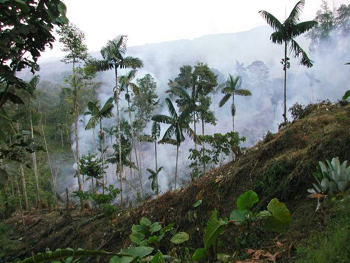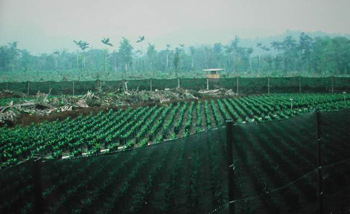Conservation more effective than biofuels for fighting global warming
Conservation more effective than biofuels for fighting global warming
mongabay.com
August 15, 2007
Conserving forests and grasslands may be a more effective land-use strategy for fighting climate change than growing biofuel crops argues a new paper published in the journal Science.
Comparing emissions from various fuel crops versus carbon storage in natural ecosystems, Renton Righelato and Dominick Spracklen write that “forestation of an equivalent area of land would sequester two to nine times more carbon over a 30-year period than the emissions avoided by the use of the biofuel.”
“Taking this opportunity cost into account, the emissions cost of liquid biofuels exceeds that of fossil fuels,” they conclude.
In developing their argument, Righelato and Spracklen note that vast areas of land would need be cleared to meet the modest goal of substituting 10 percent of oil and diesel using with biofuels: 43 percent of current cropland area in the United States and 38 percent in Europe. The authors say that the conversion of additional forest land would result in “a large up-front emissions cost that would… outweigh the avoided emissions.”

|
“For reducing carbon dioxide in the atmosphere, maintaining our forests and restoring them is much more effective than using land for biofuels,” Righelato told mongabay.com. “When forest is destroyed more CO2 is lost than can be saved in 50 years or more through producing biofuels on the cleared land.”
Righelato and Spracklen say that this will continue to be the case until carbon-free biofuel technologies are developed and introduced — probably some 30 years out into the future. By then, they suggest, the technology will exist to convert standing forest directly into biofuels.
In the meantime, the authors believe policymakers should focus on increasing the efficiency of fossil-fuel use, conserving existing forests and savannahs, and restoring natural habitats on cropland that is not being used for food production.
“In addition to reducing net carbon dioxide flux to the atmosphere, conversion of large areas of land back to secondary forest provides other environmental services (such as prevention of desertification, provision of forest products, maintenance of biological diversity, and regional climate regulation), whereas conversion of large areas of land to biofuel crops may place additional strains on the environment,” they write. “For the longer term, carbon-free transport fuel technologies are needed to replace fossil hydrocarbons.”
Renton Righelato and Dominick V. Spracklen (2007). Carbon Mitigation by Biofuels or by Saving and Restoring Forests? SCIENCE VOL 317 17 AUGUST 2007 10.1126/science.1141361
Related articles
Corn ethanol is not the solution to energy independence
(7/18/2007) A new report claims that corn ethanol will not significantly offset U.S. fossil fuel consumption without “unacceptable” environmental and economic consequences.
Is peat swamp worth more than palm oil plantations?
(7/16/2007) Could peat swamp be worth more intact for their carbon value than palm oil plantations for their oil? Quick analysis suggests yes, though binding limits on emissions will be needed to trigger the largest ever flow of money from the industrialized world to developing countries. At stake: the bulk of the world’s biodiversity.
Miscanthus bests switchgrass as biofuel source
(7/11/2007) In a side-by-side comparison, miscanthus (Miscanthus x giganteus) grass has been shown to be a more productive bioenergy source than switchgrass (Panicum virgatum), according to research presented at the annual meeting of the American Society of Plant Biologists in Chicago.
 |
U.S. ethanol may drive Amazon deforestation
(5/17/2007) Ethanol production in the United States may be contributing to deforestation in the Brazilian rainforest said a leading expert on the Amazon. Dr. Daniel Nepstad of the Woods Hole Research Center said the growing demand for corn ethanol means that more corn and less soy is being planted in the United States. Brazil, the world’s largest producer of soybeans, is more than making up for shortfall, by clearing new land for soy cultivation. While only a fraction of this cultivation currently occurs in the Amazon rainforest, production in neighboring areas like the cerrado grassland helps drive deforestation by displacing small farmers and cattle producers, who then clear rainforest land for subsistence agriculture and pasture.
 |
Environmental concerns mount as palm oil production grows
(5/15/2007) The booming market for palm oil is driving record production but fueling rising concerns over the environmental impact of the supposedly “green” bioenergy source. The two leading producers of palm oil, Malaysia and Indonesia, have rapidly expanded palm oil production in recent years, often at the expense of biodiverse rainforests and carbon-rich peatlands that store billions of tons of greenhouse gases. Environmentalists say that due to these factors, burning of palm oil can at times be more damaging the global climate than the use of fossil fuels.
